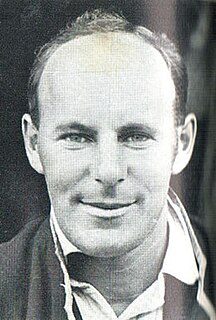| Personal information | |
|---|---|
| Born | 11 October 1941 Melbourne, Australia |
| Domestic team information | |
| Years | Team |
| 1962 | Victoria |
Source: Cricinfo, 4 December 2015 | |
Lindsay Davison (born 11 October 1941) is an Australian former cricketer. He played one first-class cricket match for Victoria in 1962. [1]

Cricket is a bat-and-ball game played between two teams of eleven players on a field at the centre of which is a 20-metre (22-yard) pitch with a wicket at each end, each comprising two bails balanced on three stumps. The batting side scores runs by striking the ball bowled at the wicket with the bat, while the bowling and fielding side tries to prevent this and dismiss each player. Means of dismissal include being bowled, when the ball hits the stumps and dislodges the bails, and by the fielding side catching the ball after it is hit by the bat, but before it hits the ground. When ten players have been dismissed, the innings ends and the teams swap roles. The game is adjudicated by two umpires, aided by a third umpire and match referee in international matches. They communicate with two off-field scorers who record the match's statistical information.
First-class cricket is an official classification of the highest-standard international or domestic matches in the sport of cricket. A first-class match is of three or more days' scheduled duration between two sides of eleven players each and is officially adjudged to be worthy of the status by virtue of the standard of the competing teams. Matches must allow for the teams to play two innings each although, in practice, a team might play only one innings or none at all.

The Victoria cricket team, who were named Victorian Bushrangers between 1995 and 2018, is an Australian first-class cricket team based in Melbourne, Victoria. The Victoria cricket team, which first played in 1851, represents the state of Victoria in the Sheffield Shield first-class competition and the Marsh One Day Cup competition. The team shares home matches between the Melbourne Cricket Ground and the Junction Oval.






